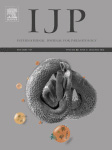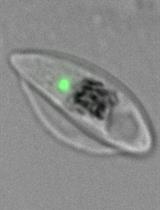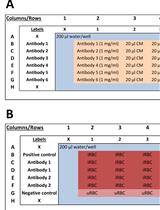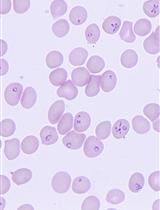- EN - English
- CN - 中文
Long-term in vitro Culture of Cryptosporidium parvum
长期体外培养小隐孢子虫
发布: 2018年08月05日第8卷第15期 DOI: 10.21769/BioProtoc.2947 浏览次数: 9236
评审: Adler R. DillmanMichael ArrowoodSmita Nair
Abstract
Continuous in vitro growth of Cryptosporidium parvum has proved difficult and conventional in vitro culture techniques result in short-term (2-5 days) growth of the parasite resulting in thin-walled oocysts that fail to propagate using in vitro cultures, and do not produce an active infection using immunosuppressed or immunodeficient mouse models (Arrowood, 2002). Here we describe the use of hollow fiber bioreactors (HFB) that simulate in vivo conditions by providing oxygen and nutrients to host intestinal cells from the basal surface and permit the establishment of a low redox, high nutrient environment on the apical surface. When inoculated with 105 C. parvum (Iowa isolate) oocysts the bioreactor produced 108 oocysts per ml (20 ml extra-capillary volume) after 14 days, and was maintained for over 2 years. In vivo infectivity studies using a TCR-α-immune deficient mouse model showed that oocysts produced from the bioreactor at 6, 12 and 18 months were indistinguishable from the parent Iowa isolate used to initiate the culture. HFB produced oocysts had similar percent excystation profiles to the parent Iowa isolate.
Keywords: Parasitology (寄生虫学)Background
Cryptosporidium parvum is an intracellular obligate parasite of the intestinal tract of man and other mammals resulting in an acute diarrhea. The disease is self-limiting in immunocompetent individuals, however, in immunocompromised adults and young children, the disease can be life-threatening (Kotloff, 2017). It is amongst the top three diagnosed enteric diseases of children in economically low resource countries (Kotloff et al., 2013; Sow et al., 2016), and is estimated to account for 9% of child deaths globally (Bhutta and Black, 2013; Checkley et al., 2015). In countries with a high burden of pediatric diarrheal disease, it has been shown that there is a correspondingly high incidence of malnutrition, stunting, and impaired cognitive functions (Lang and MA-LED Network Investigators, 2015). Despite the significant health risks and global distribution of this disease, there is no consistently effective therapy for the most-at-risk population. Recent advances in manipulating the parasite genome (Vinayak et al., 2015) and chemotherapeutic profiling (Arnold et al., 2017; Love et al., 2017; Manjunatha et al., 2017) are an encouraging sign that this bleak situation will change. Culture of the parasite has concentrated on developing a 3D culture system using adult murine colon cells (Baydoun et al., 2017) or novel bioengineered human intestinal cells (DeCicco RePass et al., 2017) which has produced novel insights into parasite invasion and significantly extended the length of culture time compared to the 2D culture method. However, these techniques are limited in terms of parasite numbers obtained. The 3D models overcome the major obstacle associated with conventional 2D culture methods where host cells receive nutrients and oxygen from the apical surface (except for those systems that use porous membrane inserts like the Costar Transwell system); this is contrary to the in vivo situation where the enterocytes receive nutrients and oxygen from the basal surface and the apical surface faces the lumen of the gut. However, current intestinal implant models fail to provide the low oxygen environment present inside the gut lumen which restricts the long-term growth of the parasite. The use of hollow fiber technology allows the creation of the biphasic environment present in the gut and overcomes many problems associated with the long-term culture of C. parvum (Morada et al., 2016). This protocol describes the establishment of hollow fiber bioreactors that can be used to simulate in vivo conditions by providing oxygen and nutrients to the basal surface of host intestinal cells that are attached to the outside of the hollow fibers (Figure 1). The environment inside the reactor is adjusted to mimic the lumen of the gut hence the apical surface of the intestinal cells are established in a low redox, high nutrient environment, that favors high growth rates and long-term maintenance of C. parvum. The use of this method provides 108-109 oocysts which can be used for molecular and biochemical studies and has the advantage of avoiding the use of harsh chemicals such as K-dichromate, which is used as a long-term storage medium at (4 °C) and has the advantage of sanitizing the oocysts; and chlorine currently used as both a sanitizer and to enhance excystation of oocysts obtained from animal sources (Arrowood, 2008).
Figure 1. Hollow Fiber Bioreactor. A. Schematic representation of the HFB; B. HFB setup.
Materials and Reagents
- BrandTechTM BRANDTM reagent reservoirs (BrandTech Scientific, catalog number: 703459 )
- Aluminum foil 18 in x 500 ft (Sigma-Aldrich, catalog number: Z185159-1EA )
- BD syringe with various tips, 60 ml (BD, catalog number: 309653 )
- BD Diagnostic Systems SYR only Luer-LokTM 10 ml 200PK RX (Thermo Fisher Scientific, catalog number: B302995)
Manufacturer: BD, catalog number: 302995 . - BD Disposable syringes with Luer-LokTM Tips, 3 ml (BD, catalog number: 309657 )
- FisherbrandTM sterile alcohol prep pads (Fisher Scientific, catalog number: 22-363-750 )
- BD VacutainerTM general use syringe needles (BD, catalog number: 305180 )
- FisherbrandTM borosilicate glass disposable serological pipets with regular tip, standard length, 5 ml (Fisher Scientific, catalog number: 13-678-27E )
- FisherbrandTM borosilicate glass disposable serological pipets with regular tip, standard length, 10 ml (Fisher Scientific, catalog number: 13-678-27F )
- FisherbrandTM borosilicate glass disposable serological pipets with regular tip, short length, 25 ml (Fisher Scientific, catalog number: 13-678-36D )
- EMD MilliporeTM MillexTM-GP sterile syringe filters with PES membrane (Fisher Scientific, catalog number: SLGP033RS)
Manufacturer: Merck, catalog number: SLGP033RS . - CorningTM polyethylene terephthalate (PET) centrifuge tubes, 15 ml (Corning, catalog number: 430055 )
- CELLSTARTM Greiner Bio-OneTM TC treated cell culture flasks, 250 ml (Greiner Bio One International, catalog number: 658175 )
- FisherbrandTM premium microcentrifuge tubes, 1.5 ml (Fisher Scientific, catalog number: 05-408-129 )
- FisherbrandTM low-retention pipet tips–filtered, 10 μl (Fisher Scientific, catalog number: 02-717-158 )
- FisherbrandTM low-retention pipet tips–filtered, 20 μl (Fisher Scientific, catalog number: 02-717-161 )
- FisherbrandTM low-retention pipet tips–filtered, 200 μl (Fisher Scientific, catalog number: 02-717-165 )
- QuibitTM assay tubes (Thermo Fisher Scientific, InvitrogenTM, catalog number: Q32856 )
- MicroAmpTM optical 96-well reaction plate with barcode (Thermo Fisher Scientific, Applied BiosystemsTM, catalog number: 4306737 )
- MicroAmpTM optical adhesive film (Thermo Fisher Scientific, Applied BiosystemsTM, catalog number: 4311971 )
- Filters, bottle top 1 L (Thermo Fisher Scientific, catalog number: 597-4520 )
- DynabeadsTM MPCTM-S magnetic particle concentrator (Thermo Fisher Scientific, catalog number: A13346 )
- DynabeadsTM MPCTM-6 magnetic particle concentrator (Thermo Fisher Scientific, catalog number: 12002D )
- DynabeadsTM L10 tubes (Thermo Fisher Scientific, catalog number: 74003 )
- VWR® 8-425 screw thread vials (VWR, Avantor, catalog number: 66020-950 )
- Cap screw top black, with PTFE/silicone pre-slit septa, 10 mm, packed in a clean environment (PerkinElmer, catalog number: N9306052 )
- C. parvum 18S-rRNA primers: Cp18S-995F: 5’-TAGAGATTGGAGGTTCCT-3’ and Cp18S-1206R: 5’-CTCCACCAACTAAGAACGCC-3’ (Thermo Fisher Scientific, Waltham, MA, USA)
- Human 18S-rRNA primers: Hs18S-F1373: 5’-CCGATAACGAACGAGACACTCTGG-3’ and Hs18S-R1561: 5’-TAGGGTAGGCACACGCTGAGCC-3’ (Thermo Fisher Scientific, Waltham, MA, USA)
- Quant-iTTM Qubit RNA BR assay kit (Thermo Fisher Scientific, InvitrogenTM, catalog number: Q10211 )
- RNeasy mini kit, 250 (QIAGEN, catalog number: 74106 )
- RNase-free DNase set, 50 (QIAGEN, catalog number: 79254 )
- iScriptTM RT-qPCR sample preparation reagent (Bio-Rad Laboratories, catalog number: 1708898 )
- Luna® Universal one step RT-qPCR kit protocol (New England BioLabs, catalog number: E3005 )
- Sterile phosphate buffered saline (Thermo Fisher Scientific, GibcoTM, catalog number: 10010049 )
- Minimum Essential Medium (MEM) with L-glutamine and phenol red, without HEPES (Thermo Fisher Scientific, GibcoTM, catalog number: 11095-114 )
- Horse Serum, New Zealand origin (Thermo Fisher Scientific, GibcoTM, catalog number: 16050122 )
- UltraPureTM DNase/RNase-free distilled water (Thermo Fisher Scientific, InvitrogenTM, catalog number: 10977015 )
- Ethanol, 70% (Sigma-Aldrich, catalog number: 1009744000)
Manufacturer: Merck, catalog number: 100974 . - Roche DiagnosticsTM glucose test strips for Accutrend® Plus meters (Fisher Scientific, catalog number: 22-045-871)
Manufacturer: Roche Diagnostics, catalog number: 11447475160 - Crypt-a-GloTM reagent only kit (Waterborne, catalog number: A400FLR-20 )
- Sporo-GloTM (Waterborne, catalog number: A600FLR-20X )
- Trypsin-EDTA (0.25%), phenol red (Thermo Fisher-Scientific, GibcoTM, catalog number: 25200056 )
- L-glutamine (Sigma-Aldrich, catalog number: G3126 )
- HEPES (Sigma-Aldrich, catalog number: H3375 )
- D-glucose (Sigma-Aldrich, catalog number: G8270 )
- Ascorbic acid (Sigma-Aldrich, catalog number: A0278 )
- P-Aminobenzoic acid (Sigma-Aldrich, catalog number: A9878 )
- Calcium pantothenate (Sigma-Aldrich, catalog number: C8731 )
- Folic acid (Sigma-Aldrich, catalog number: F7876 )
- Heparin (Sigma-Aldrich, catalog number: H3393 )
- Antibiotic/antimycotic 100x (Thermo Fisher Scientific, catalog number: 15240062 )
- Taurodeoxycholate (Sigma-Aldrich, catalog number: T0557 )
- Thioglycolic acid (MP Biomedicals, catalog number: 102933 )
- Mannitol (Sigma-Aldrich, catalog number: M4125 )
- Glutathione (Sigma-Aldrich, catalog number: G6013 )
- Taurine (Sigma-Aldrich, catalog number: T8691 )
- Betaine hydrochloride (Sigma-Aldrich, catalog number: B3501 )
- Cysteine (Sigma-Aldrich, catalog number: C7352 )
- Oleic acid (Sigma-Aldrich, catalog number: O1257-10MG )
- Cholesterol (Sigma-Aldrich, catalog number: C4951-30MG )
- DynabeadsTM anti-Cryptosporidium (Thermo Fisher Scientific, catalog number: 73011 )
- Nitrogen Medical Grade 99.998% purity (TW Smith, Brooklyn, NY)
- Carbon dioxide, Bone Dry, 99.998% (TW Smith, Brooklyn, NY)
- ECS medium mix (see Recipes)
- ICS medium mix (see Recipes)
Equipment
- 1 L Bottles, 33 mm cap (Fisher Scientific, catalog number: 0642114)
Manufacturer: DWK Life Sciences, catalog number: 61111T1000 . - 125 ml Bottles, 33 mm cap (DWK Life Sciences, catalog number: 219755 )
- Roche DiagnosticsTM glucose controls for Accutrend® Plus meters (Fisher Scientific, catalog number: 22-045-733)
Manufacturer: Roche Diagnostics, catalog number: 05213231160 . - HausserTM LevyTM hemacytometer chamber set (Hausser Scientific, catalog number: 3520 )
- FiberCellTM Systems Duet Pump (FiberCell Systems, catalog number: P3202 )
- Hollow Fiber Medium Cartridge (FiberCell Systems, catalog number: C2011 )
- UVP UV2 Sterilizing PCR Workstation (VWR, Avantor, Bridgeport, NJ 08014, USA)
- Class II, Type A, Biohazard Cabinet, model number 10276 (Envirco Cedar Grove, NJ 07009, USA)
- Beckman Coulter Microfuge® 16 centrifuge (Beckman Coulter, model: Microfuge® 16 )
- EppendorfTM centrifuge 5810R (Eppendorf, model: 5810 R )
- Quant Studio 6 Flex 44 (Applied Biosystems, Life Technology, Thermo Fisher Scientific, Waltham, MA, USA)
- Thermo Scientific Revco Ultima CO2 incubator (Thermo Fisher Scientific, Waltham, MA, USA)
- DynabeadsTM MX mixer base (Thermo Fisher Scientific, catalog number: 15902 )
- QubitTM 3.0 fluorometer (Thermo Fisher Scientific, catalog number: Q33216 )
- NikonTM Optiphot fluorescence microscope (Nikon, Westbury, NY)
- Fisher Scientific Accumet® AR10 pH benchtop meter (Fisher Scientific, catalog number: 13-636-AB150 )
- Fisher Scientific dry bath incubator (Fisher Scientific, catalog number: 11-718-2 )
- Autoclave (LBR Scientific, Rutherford, NJ)
Software
- Quant Studio RT-PCR software v1.0 (Applied Biosystems, Life Technology, Thermo Fisher Scientific, Waltham, MA, USA)
- Sigma Plot v2001 (Systat Software, Inc, San Jose, CA, USA)
Procedure
文章信息
版权信息
© 2018 The Authors; exclusive licensee Bio-protocol LLC.
如何引用
Yarlett, N. and Morada, M. (2018). Long-term in vitro Culture of Cryptosporidium parvum. Bio-protocol 8(15): e2947. DOI: 10.21769/BioProtoc.2947.
分类
微生物学 > 微生物细胞生物学 > 细胞分离和培养
细胞生物学 > 细胞分离和培养 > 3D细胞培养
您对这篇实验方法有问题吗?
在此处发布您的问题,我们将邀请本文作者来回答。同时,我们会将您的问题发布到Bio-protocol Exchange,以便寻求社区成员的帮助。
Share
Bluesky
X
Copy link












